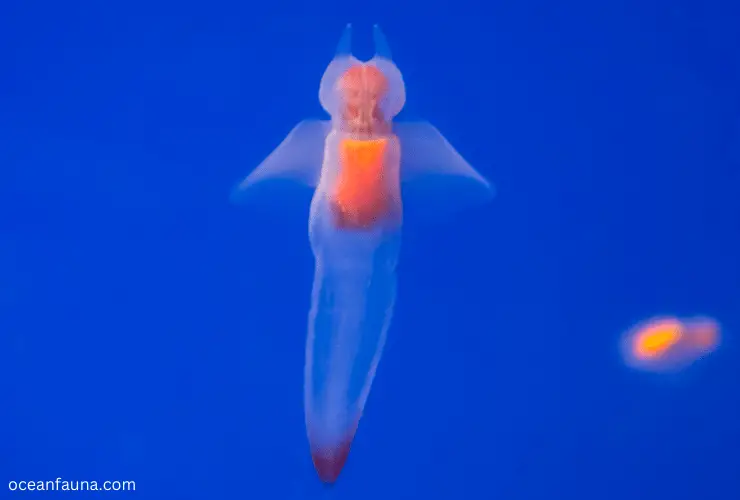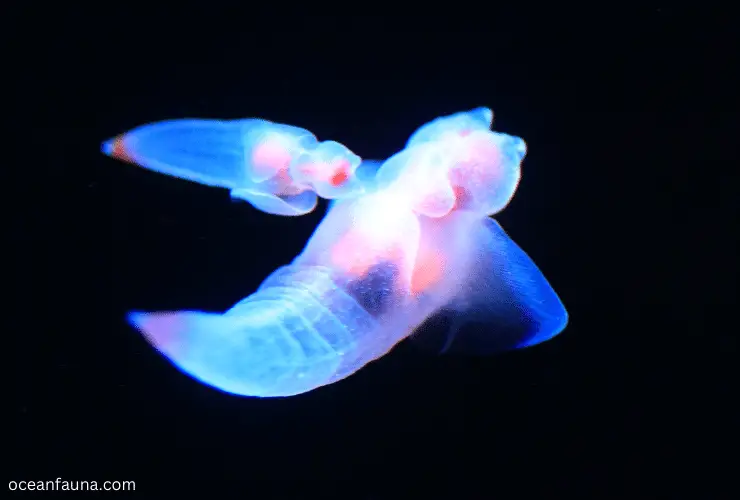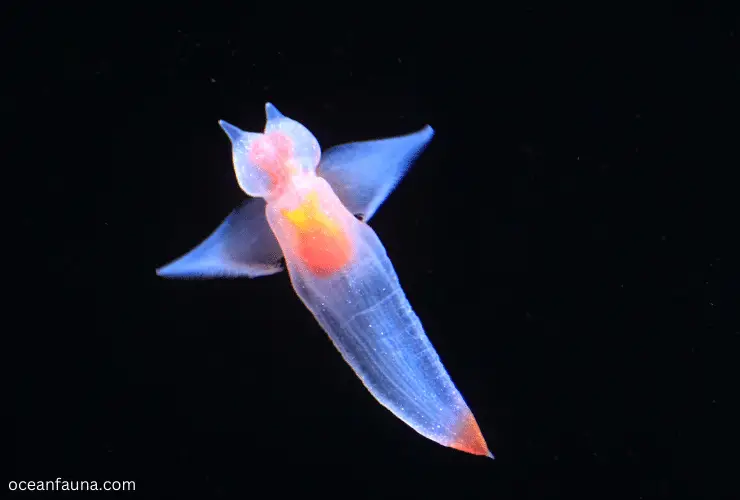Millions of tiny, transparent, and beautiful-looking marine creatures exist from the poles to the tropics, sea waters to oceans. And the sea butterfly is one of them! Sea butterflies are tiny sea slugs with winglike appendages found in almost all types of waters across the globe.
Sea butterflies are tiny little marine creatures that have a length of up to a centimetre. They have tiny wings and are often misunderstood as sea angels. They are passive feeders and depend on plankton to get their food. Besides, sea butterflies are hermaphrodites. That means both males and females have reproductive organs.
Sea butterflies are unique, magical, and mysterious. They remain almost 100 metres deep in the ocean, even being microscopic in size.
So, if you’re one of those who are eager to know about sea butterflies, you’re at the right place. Read to the end to learn about these mystic and mysterious creatures and discover unbelievable facts about them!
Sea Butterfly At a Glance
Sea butterflies have a lot of unique facts and characteristics that might not be easy to understand and process in the first place.
However, for better understanding and to give you a slight idea about the overall characteristics of sea butterflies at a glance, a chart is provided below-
| Size | Tiny size. Has a length of up to 1 cm |
| Lifespan | For arctic- 1 year For Subarctic- 2 years |
| Appearance | Mainly transparent. Orange-red colour around the head. Has a hard shell |
| Habitat | Abundant all over the world, in all seas and oceans |
| Food habitat | Herbivorous. Eats planktons |
| Reproduction System | Hermaphrodites. Both males and females possess reproductive organs |
| Threats | Acidification. |
Everything You Need to Know About Sea Butterfly
In the above chart, we gave you an overall idea of the characteristics of sea butterflies. However, to know things more clearly and get an in-depth idea, you need to know more than just this.

That’s why we did the hard work for you and arranged the things in a systematic order so that you can clearly know about this interesting marine creature.
So let’s dive deeper…
Taxonomy
I guess you already know that all living organisms have a scientific name on the basis of their characteristics and groups. Sea butterflies have also been named according to their body types, shapes, characteristics, etc.
The sea butterfly is a type of planktonic marine snail belonging to the family Thecosomata, and its scientific name is Limacina helicina. They fall under pelagic sea snails.
For your better understanding of the proper taxonomy of sea butterflies, a chart is provided below that consists of the full taxonomy of it-
| Kingdom | Animalia |
| Phylum | Mollusca |
| Class | Gastropoda |
| Subclass | Pteropoda |
| Order | Thecosomata |
| Suborder | Gymnosomata |
| Family | Limacinidae |
| Genus | Limacina |
Sea Butterflies Have a Majestic Appearance
Underwater creatures have always been a surprise, and one of those reasons is due to their unique body shape and structure. And that’s the same case for Sea butterflies as well.
The sea butterfly is beautiful and majestic. In fact, they are one of the most beautiful tiny creatures due to their appearance.
Also Read: 25 Fish with Legs: Amazing Facts with Images
Sea butterflies are tiny in size and shape. In fact, they range up to a few centimetres in length. However, some reports suggest that sea butterflies are less than a centimetre in length.
Coming to the body colour, sea butterflies are basically transparent. However, they have an orange-red colored head, a tail, and a gut to easily notice them in the ocean.
Instead of regular wings, they have a set of developed parapodia or lobes. These act as their wings. Using the developed parapodia or lobes, they swim through the ocean water and heavy currents under the sea.
By their appearance, they’re often considered or misunderstood as sea angels. However, they’re not the same as sea angels because sea angels don’t have a calcified transparent shell which is often seen in the case of sea butterflies.
As sea butterflies have a calcium carbonate shell body, they use this to balance the acidity in the ocean and adapt themselves to the environment.
Where Are Sea Butterflies Found?
Sea butterflies are known as pelagic animals or creatures. This is because sea butterflies are found in almost all open waters.
The living place of sea butterflies is deep waters. That’s why they’re hardly seen on the shores or sea floors.
Now you might be thinking, in which location are sea butterflies found abundant?
Well, for your information, sea butterflies are mainly seen in the waters of the western coast of America. They are found mainly between British Columbia and California. Besides, tiny marine creatures are also found in the North Atlantic Ocean.
Reading this far, there arises another question. At what heights do sea butterflies live?
Well, Sea butterflies can be seen at moderate depths or extreme depths as well. Normally, sea butterflies live at around 25 metres. But they’re also found at greater heights of around 100 metres as well.
What Do Sea Butterflies Eat?
Sea butterflies are passive feeders. Their main source of food is tiny plankton under the sea.
Sea butterflies have a special gland to capture the food or the tiny plankton. The gland has a mucous web like a net that helps them to take the plankton as food.
One of the most interesting facts is the mucous membrane they use to capture the plankton is 5 cm, which is bigger than the body itself. And while taking the food, if somehow the membrane is disturbed, they immediately throw away the web-like nets!
How Long Do Sea Butterflies Live?
The lifespan of all sea butterflies aren’t the same. In fact, the lifespan depends upon the type of environment they’re living in.
Typically, the life span of sea butterflies is around 1 to 2 years.
The sea butterflies that live in the Arctic have a lifespan of 1 year. On the other hand, sea butterflies living in the Subarctic have 2 years of lifespan.
How Do Sea Butterflies Reproduce?
Sea butterflies are hermaphrodites. That means sea butterflies, irrespective of male and female; both possess reproductive organs.
During the early stage, that means they remain as males until they develop into a butterfly.
Also Read: How Do Sea Urchins Reproduce? [Explained]
The reproduction process of sea butterflies is another unique and exciting thing.
The males mate with males during reproduction. During mating, their sperm remain stored until they turn out as females. Once they start to develop as a female, their male reproductive organ vanishes.
Female sea butterflies mainly release their eggs into the seawater. The floating egg mass later turns into swimming larvae once they are developed.
What Are the Main Threats for Sea Butterflies?
Sea butterflies are sensitive. Despite having predators in the seas or oceans, their main threat is a change of environment or habitat.
As you already know, sea butterflies have an aragonitic shell on the outer side of their body. Due to this, they can sustain in water with high PH or acidity.
However, with the rapid increase of acidity in the environment, the water’s acidity is also changing. This negatively impacts their lifestyle and might result in the extinction of this beautiful marine creature.
Other than water’s acidity, sea butterflies also have certain predators.

Sea butterflies are microscopic and extremely tiny. Due to their tiny size, they’re an easy target for other marine creatures. Besides, their tiny body structure makes them helpless against predators as well.
The main predators of sea butterflies in seas and oceans are whales and other big fishes. On top of these, there are a few seabirds as well that consume them as food.
Do Sea Butterflies Sting?
The short answer is NO. Sea butterflies do not sting. Unlike jellyfish and some other ocean creatures, sea butterflies do not have stinging cell. They have other strategies to get food and defend themselves from predators.
Amazing Facts About Sea Butterflies
Sea butterflies are one of the most graceful-looking marine creatures living under hundreds of feet in the ocean.
From having a unique body structure to having a distinctive reproduction system, here are some of the most amazing facts about sea butterflies-
1. Sea Butterflies Are Not Related to Butterflies
From the name, you might think that sea butterflies are related to butterflies; in reality, they have no connection between them!
Also Read: Are Seahorses Related to Horses? [Real Answer]
Sea butterflies have wings, and they can fly too. They have begun their life in a larval stage like other butterflies. But the main difference is that sea butterflies are tiny marine creatures, mostly related to snails, and are pteropods.
2. Reason Behind Naming
There’s a reason behind the naming of sea butterflies. Firstly, they’re called “sea butterflies” due to their elegant swimming style.
Although they have wings absent in their body, they use their developed parapodia or lobes for swimming through the ocean currents.
3. Potato Chip of The Sea
Sea butterflies are called the “potato chip of the sea,” which is quite an unknown fact to most people.
Sea butterflies are often taken as food by many marine creatures. Be it large whales or medium-sized fish; many marine creatures take sea butterflies as food alongside plankton and other things.
As sea butterflies are the food to many fishes and Arctic marine species, they’re called the potato chip of the sea!
4. Hermaphroditic
Sea butterflies are Hermaphroditic due to their distinctive reproduction system. During the early stage, sea butterflies remain as males and develop a male reproductive organ. Even when they mate, the sperms are contained until the male reproductive organ vanishes and turn out like females to lay eggs.
5. Found in All Open Oceans
Sea butterflies are abundant worldwide in all open seas and oceans. They are widely available from the western coast of America to the North Atlantic Ocean.
6. No Visible Eyes
Sea butterflies have no visible eyes. In fact, they don’t have a resembling face. Due to their tiny structure, they are hardly seen by the naked eye.
7. Different from Sea Angels
Sea butterflies and sea angels are different, although they look quite the same. Sea butterflies have hard outer shells, whereas the shell is absent in sea angels. Aside from this, many other key differences make sea butterflies different from sea angels.
Why Are Sea Butterflies and Sea Angels Different?
Although sea angels and sea butterflies might look similar, they’re not the same.
Sea butterflies were considered the same as sea angels for a long time. However, after much research and observations, it was found that, even though they belong to the same group and have a few similar characteristics, they are different!
Sea angels and sea butterflies both fall under snails. Sea angels have a pair of winglike structures called parapodia. They use this wing for swimming through the waters. Besides, sea angels are transparent, they have a jelly-like gelatinous body, and there is no shell present in their bodies!
Differences Between Sea Angels and Sea butterflies
To help you clearly understand the differences between sea butterflies and sea angels, we’re providing a detailed comparison. So I highly believe it’ll help you differentiate between the two similar types of microscopic marine creatures.
Outer Shell
Sea angels and sea butterflies are both known as swimming sea snails and slugs. In fact, they both are pteropods.
The main difference can be made by looking at their appearance. In sea angels, there is no outer shell present. But in the case of sea butterflies, you can find a hard outer shell.
Size
The size is another differentiating factor between sea angels and sea butterflies.
Typically, sea butterflies are tiny. They range up to 1 centimetre in length. Whereas sea angels are typically larger in length, They are almost 1-2 inches in length.
Living Habitat
The living habitats of sea angels and sea butterflies are different. Sea angels typically live at greater heights of around 600 metres in cold and temperate waters. On the other hand, sea butterflies live between 25 to 100 metres.
Food Habitat
The main food or food source of sea butterflies is tiny plankton under the ocean or seawater. On the other hand, sea butterflies are one of the favourite foods of sea angels.
Some sea angels have finger-like tentacles in their heads. They use it to capture their prey.
So these are the main key points that make sea angels different from sea butterflies!
FAQ
Is a sea butterfly rare?
Ans: No, sea butterflies are not rare. Sea butterflies are found all over the world in all types of oceans. They are a source of food for other marine creatures.
Where can you find a sea butterfly?
Ans: Sea butterflies are found all over the world. Sea butterflies are mainly seen in deeper, open seas away from shorelines or in aquatic zones. On top of that, sea butterflies are adaptive and live in cold and warm water bodies.
What does a sea butterfly do?
Ans: Sea butterfly is a tiny snail or pteropod that is a good food source for other marine and aquatic creatures. They are eaten by almost all types of fishes and creatures living under the oceans or seas.
Can You Eat Sea butterflies?
Ans: Sea butterflies are mainly eaten by fishes and creatures under the oceans. But if they’re eaten in large quantities, fishes often get a back gut, making them unsellable. So sea butterflies have commercial importance as well!
Is Sea Butterfly Endangered?
Ans: Yes, sea butterflies are in danger due to the rapid increase of acid in ocean waters. Due to more releases of CO2 in the environment, ocean waters are also becoming CO2-enriched. As a result, the acidity is increasing, making it difficult for sea butterflies to live under the ocean.
Conclusion
So that’s all about knowing about the beautiful, majestic, and distinctive marine creature, i.e., sea butterfly.
Although sea butterflies are tiny in structure, they hold a greater value for other marine creatures as they’re one of the primary food sources under the waters.
Aside from their importance as a food source, sea butterflies have some unique and amazing facts that truly differentiate them from others.
As you read this far, we believe you have now discovered those facts. And now it’s your turn to enlighten others about this tiny creature.


Informative article, Sea butterflies are real?! I thought they were mythical creatures created by Barbie Mermaidia. If a sea butterfly flaps its wings in the arctic, does that cause a hurricane in the tropics?